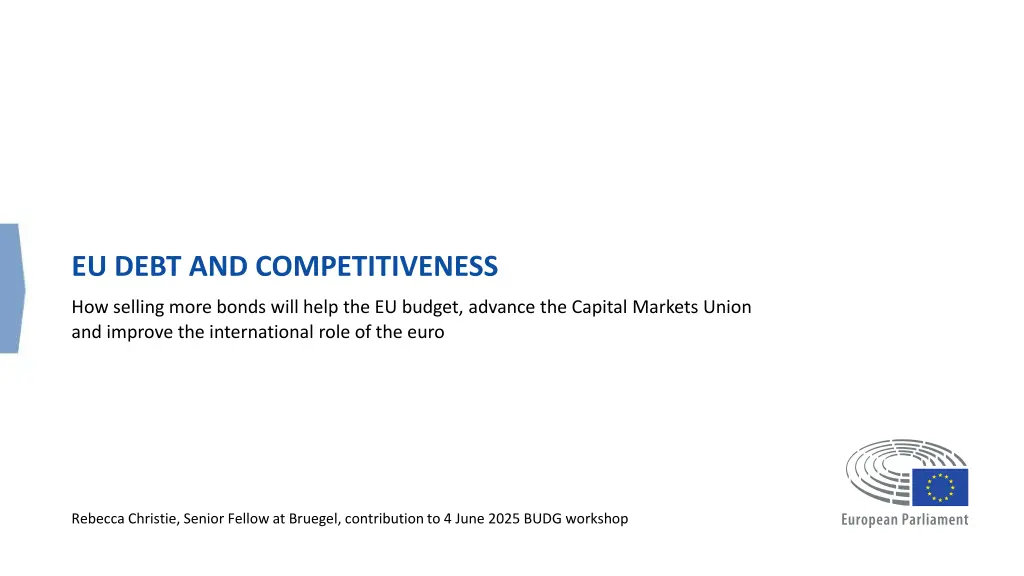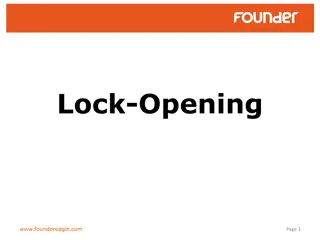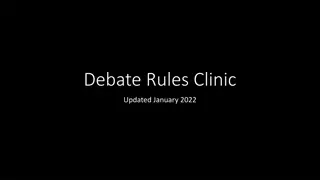
EU Debt and Competitiveness: The Impact of Selling More Bonds
Explore how increasing bond sales can benefit the EU budget, boost the Capital Markets Union, and enhance the international standing of the euro. Delve into the evolution of joint debt utilization, the significance of safe assets, and the breakthrough in EU debt management during the pandemic.
Download Presentation

Please find below an Image/Link to download the presentation.
The content on the website is provided AS IS for your information and personal use only. It may not be sold, licensed, or shared on other websites without obtaining consent from the author. If you encounter any issues during the download, it is possible that the publisher has removed the file from their server.
You are allowed to download the files provided on this website for personal or commercial use, subject to the condition that they are used lawfully. All files are the property of their respective owners.
The content on the website is provided AS IS for your information and personal use only. It may not be sold, licensed, or shared on other websites without obtaining consent from the author.
E N D
Presentation Transcript
EU DEBT AND COMPETITIVENESS How selling more bonds will help the EU budget, advance the Capital Markets Union and improve the international role of the euro Rebecca Christie, Senior Fellow at Bruegel, contribution to 4 June 2025 BUDG workshop
DEBT AS AN OWN RESOURCE The European Union is in search of additional revenues to augment its existing own resources. Not all of the promised new revenues in the EU Council s 2020 statement establishing NGEU have come to fruition, notably a digital levy and a financial transactions tax. Joint debt has made a small-scale contribution to EU budgets for some time Before the euro crisis, Member States were leery of any joint borrowing at scale During the euro crisis, Member States experimented with other ways of joint market access. EU Commission borrowing was not expanded much at that time The official history of the ESM gives a detailed technical and legal history of the various joint borrowing vehicles established
THE JOINT DEBT BREAKTHROUGH During the pandemic, EU leaders overcame their previous reluctance to borrow at scale Borrowing through the EU Commission is a much more efficient way to access debt markets than through a special purpose vehicle The Commission has built a top-quality debt management office, including a strong primary dealer network and consolidated mix of securities Diversified funding strategy is a major technical accomplishment Chart credit: EU Commission investor relations
SAFE ASSET WITHIN REACH A safe asset is a new and positive development Draghi Report: It is unquestionable that the issuance of a common safe asset would make the CMU much easier to achieve and more complete - would provide pricing benchmark, common collateral Letta Report: long-term recommendation to consolidate EU institutional debt into one larger and more liquid issuance. But not possible given range of governance structures EU bonds is the best of the bunch because it was created by unanimous consent of the leaders, because it includes all 27 member states Investor demand is quite high, bond sales are regularly oversubscribed, and EU bonds are rated AAA Debt financing can, at least theoretically, be used as an own resource (Grund and Steinbach, 2023) Please see Grund, S. and A. Steinbach (2023) European Union debt financing: leeway and barriers from a legal perspective , Working Paper 15/2023, Bruegel, available at https://www.bruegel.org/working-paper/european-union-debt-financing-leeway-and-barriers-legal- perspective
SAFE ASSET VS TOP-RATED DEBT Total outstanding marketable US Treasury debt: An EU safe asset is distinct from the presence of low-risk assets About $29 trillion US Treasury bonds have traditionally been the world s best quality safe asset, in part because there are so many of them. US Treasury securities exist in large quantities at every point on the yield curve. They can be bought and sold in all market conditions Total outstanding marketable EU-level institutional debt: About 1.1 trillion There is no comparable euro-denominated security.
EURO-DENOMINATED DEBT IS MOSTLY NOT TOP QUALITY Top-rated assets are a minority of euro-denominated government debt Source: Bruegel based on Bloomberg for bonds issued by EFSF, EU, ESM and EIB, S&P for credit ratings and Eurostat for government debt securities. Note: includes bonds issued by the 19 euro-area countries, the European Financial Stability Facility, the European Union, the European Stability Mechanism and the European Investment Bank. Chart by Costanza Greppi and Marie-Sophie Lappe for Bruegel
WE DONT NEED A NEW SPECIAL PURPOSE VEHICLE Creating yet another new issuer would be a step backward Credit ratings of the Big Five Any new SPV would be dependent on the credit ratings of participating countries. As rated by S&P, Moody s et al Germany: AAA For big initiatives like defense, the probable coalition of the willing would not collectively have strong enough ratings to get a triple A group rating France: AA-/Aa3 Italy: BBB/Baa3 Given that the EU already has a top-rated joint debt instrument, it seems inefficient to spend months building something new that most likely would not be as good Poland: A-/A2 UK: AA/Aa3 The big 5 defense countries, while admirably showing post-Brexit solidarity, don t look like natural candidates for joint borrowing in a new and independent context
SAFE ASSET WITHOUT FISCAL UNION To have a safe asset, you do not need fiscal union You just need to sell more bonds Any consideration of new EU joint or pooled debt therefore needs to keep market dynamics in mind Now that investors have shown demand for and trust in EU bonds, a return to SPVs or tranched and pooled securities would be a step backwards This suggests the debate should move on from ESBies, blue bonds/red bonds etc EU debt has investor credibility, even if EU debt is still mostly considered supranational debt and not sovereign debt
INVESTORS WANT AN ALTERNATIVE TO THE DOLLAR Incremental steps can have a big impact in terms of long-term supply and demand Keeping existing debt levels by rolling over current debt would be a good next step, without increasing EU liability or member stage guarantees Leaders also could, as a further step, agree to create further one-off programs like NGEU to gradually increase the share of marketable bonds Now that investors have shown demand for and trust in EU bonds, a return to SPVs or tranched and pooled securities would be a step backwards A safe asset is a public good in its own right As of June 2, outstanding EU bonds stood at 646 billion, spread across the yield curve, with an investor base from more than 70 countries
MORE DEBT IS SAFER DEBT A government is not a business, its finances are different Credibility is a fundamental in its own right (eg Cadamuro and Papadia, 2022) available at https://www.bruegel.org/blog-post/national-policies-are-best-protection-against-euro-area-financial-fragmentation-risks As with electricity grids, public debt carries risk that must be managed carefully We plan for what we can do with the debt, just as we plan for keeping the lights on and not starting fires US Treasury debt has long benefited from two-way demand: when times are good, people buy dollars to make money. When times are bad, people buy dollars as a flight to quality Particular given the uncertain and high tariff environment (Merler 2025), the EU should offer more securities for investors seeking an alternative available at https://www.bruegel.org/first-glance/more-eu-debt-issuance-would-be-best-response-trumps-tariffs
Thank you for your time. For any questions, comments or other communication, you can find me at: Rebecca Christie Senior Fellow, Bruegel rebecca.christie@bruegel.org Phone: +32 495 120 733 www.bruegel.org Rue de la Charit 33-1210 Brussels Belgium






















